Served with a red wine reduction sauce, this Japanese Hamburger Steak (Hambagu) is big on flavors. The meat is juicy and melts in your mouth. It‘s perfect to make in a hot frying pan either in the kitchen or on the grill!
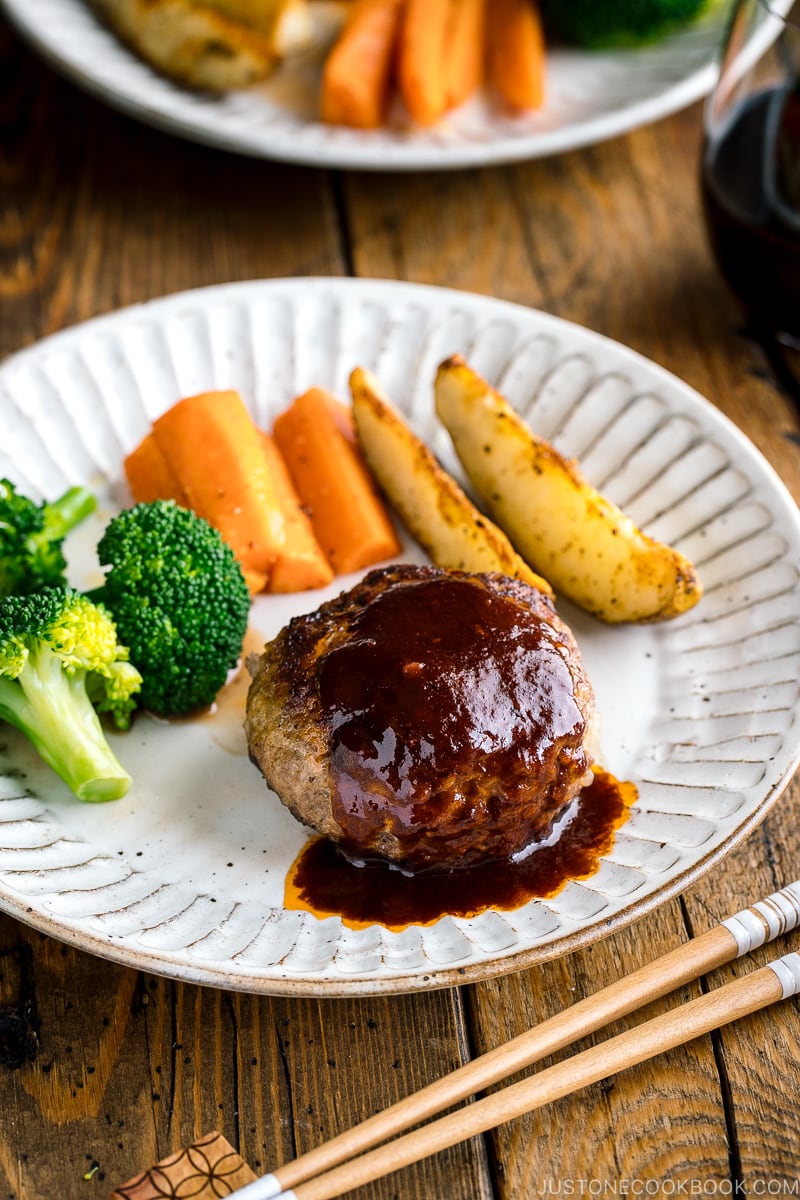
I still remember vividly how my mom and I spent many evenings making Japanese Hamburger Steak or Hambagu (ハンバーグ). If I was home, she would call me around 4:30 PM and always encouraged my presence in the kitchen. Unless I was in the middle of a novel that I couldn’t stop reading, I didn’t mind helping her out most of the time. That’s how I learned to cook Japanese food from her.
What is Hambagu
Japanese Hamburger Steak, or we call it Hambāgu (ハンバーグ) or Hambāgu Steak (ハンバーグステーキ), is a popular dish enjoyed both at home and at Yoshoku (Japanese style western food) restaurants. It’s a steak made from ground meat and usually served with rice rather than buns.
While researching facts about Hambāgu on Japanese Wiki, I learned that there is an American version of hamburger steak and it’s very similar to a dish called Salisbury Steak, which I’ve never tried before.
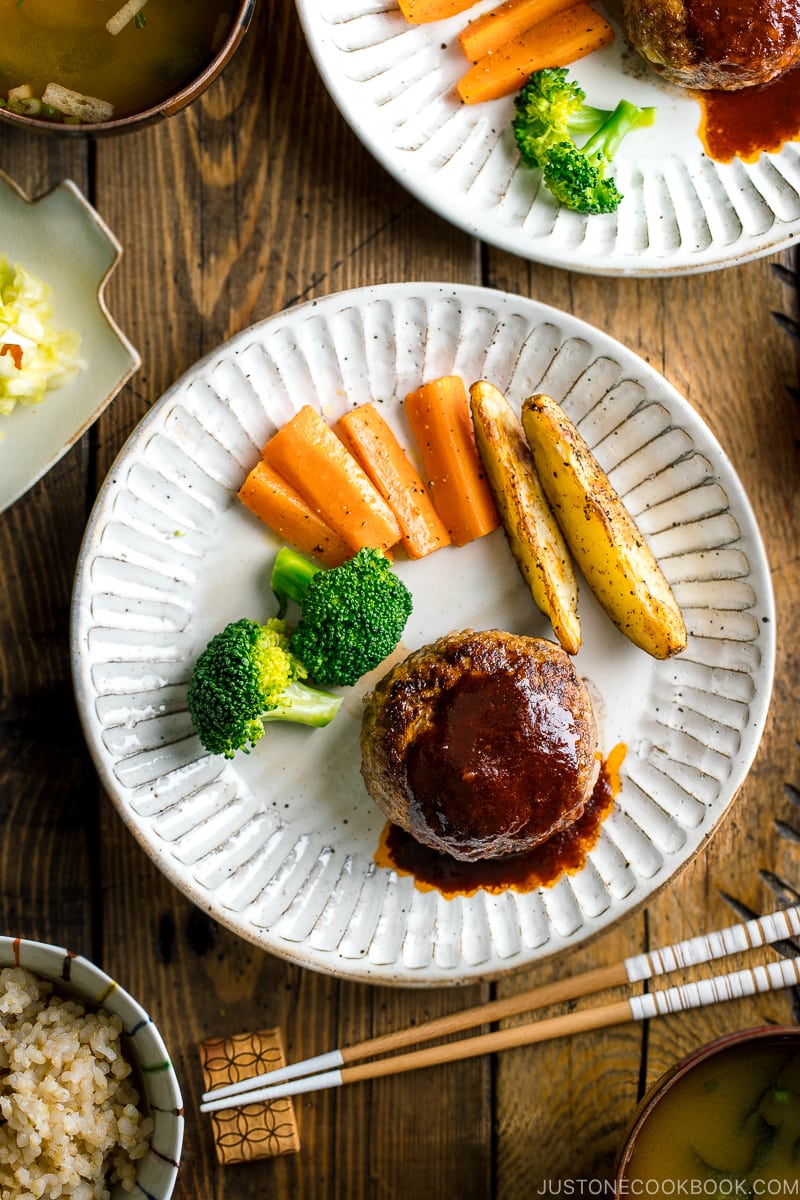
Variations of Japanese Hamburger Steak
The common theme for all these hamburger steaks is that they are made from a blend of minced beef and other ingredients.
There are many variations of Hambāgu in Japan, like Wafu Hambāgu (soy sauce-based sauce with grated daikon), Teriyaki Hambāgu, Demi-glacé Hambāgu, and more. You’ll also find different topping options, such as sautéed shimeji mushrooms and a fried egg.
Today I’m sharing the basic Hambāgu recipe with a delicious homemade sauce.
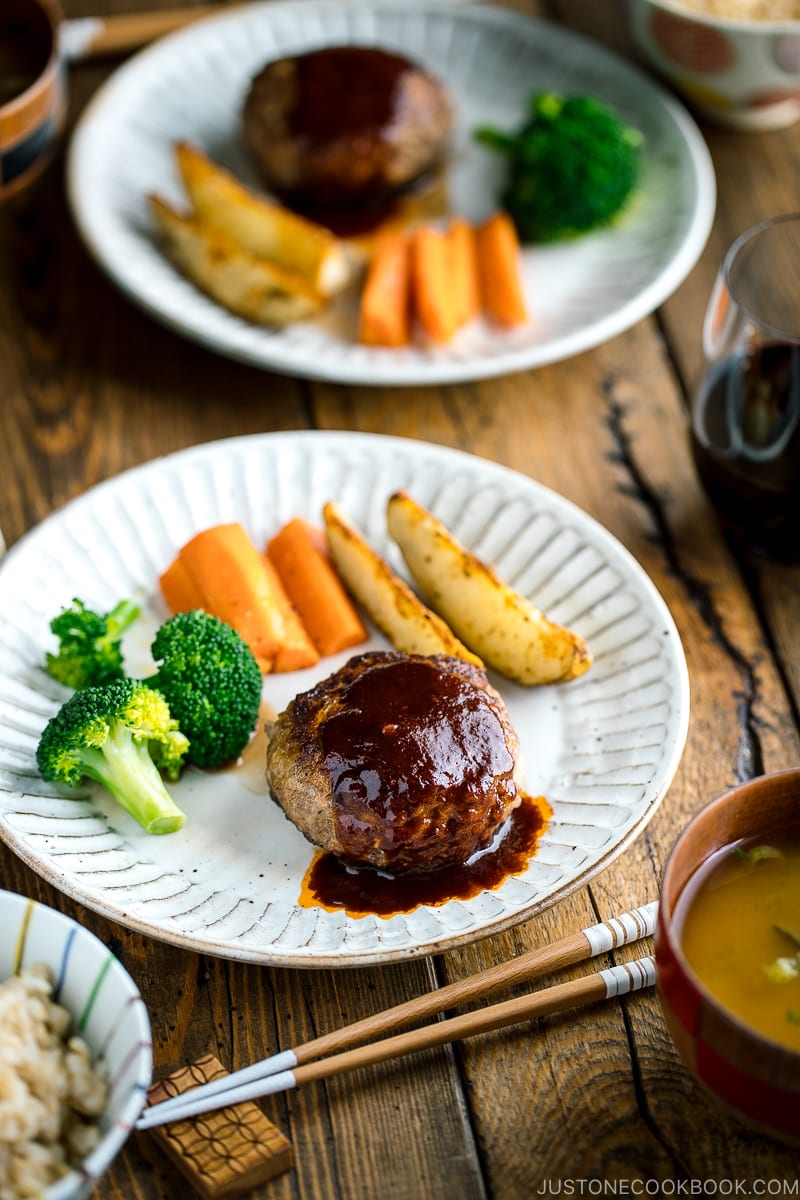
Use of Both Ground Beef and Ground Pork
Hambāgu in Japan is typically made from both ground beef and ground pork. Supermarkets in Japan sell a convenient package of both ground beef and ground pork (we call it Aibiki Niku 合いびき肉) so that we don’t have to buy the meat separately. The common ratio of Aibiki Niku is 7:3.
For this Hambagu recipe, you can decide the beef/pork ratio either 2:1 (8 oz/4 oz) or 3:1 (9 oz/3 oz).
We often use this Aibiki Niku for Menchi Katsu, Spaghetti Meat Sauce, Curry Doria (Rice Gratin), and Hambāgu recipes.
7 Tips to Make Perfect Hamburger Steak
To enhance the flavor of Hambāgu, below are a few important tips, which I learned from my mom. I also included a video on how to toss hamburger steak to force out the air pockets.
- Sauté onion slowly and then cool it down completely. The cooked onion will add natural sweetness to Hambāgu.
- Knead the mixture with your hand until it’s pale and sticky.
- Play catch, tossing meat mixture from your left hand to your right hand. Do this a couple of times in order to release the air inside. If you skip it, the hambagu will crack while cooking.
- Let the meat patties cool in the refrigerator for 20-30 minutes to solidify fats and take them out right before cooking.
- Indent the center of each patty with 2-3 fingertips to avoid explosion or crumbling of the meat patties when you cook. The meat will expand during cooking, and the indentation will disappear.
- Use wine for steam cooking and the delicious sauce. If you can’t consume alcohol, use beef/chicken stock instead.
- Cook the red wine reduction sauce in the same pan. The rich grease left in the pan adds another layer of flavor to the already juicy Hambāgu.

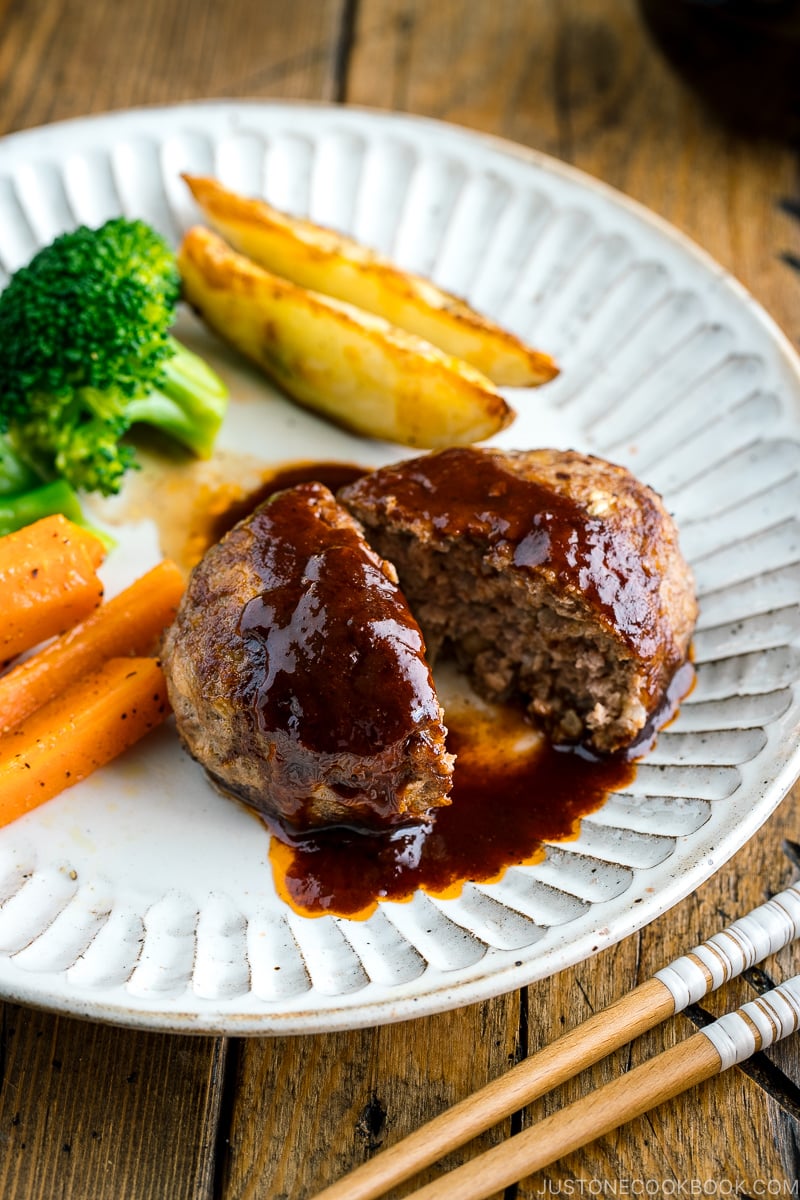
How to Serve with Hambagu
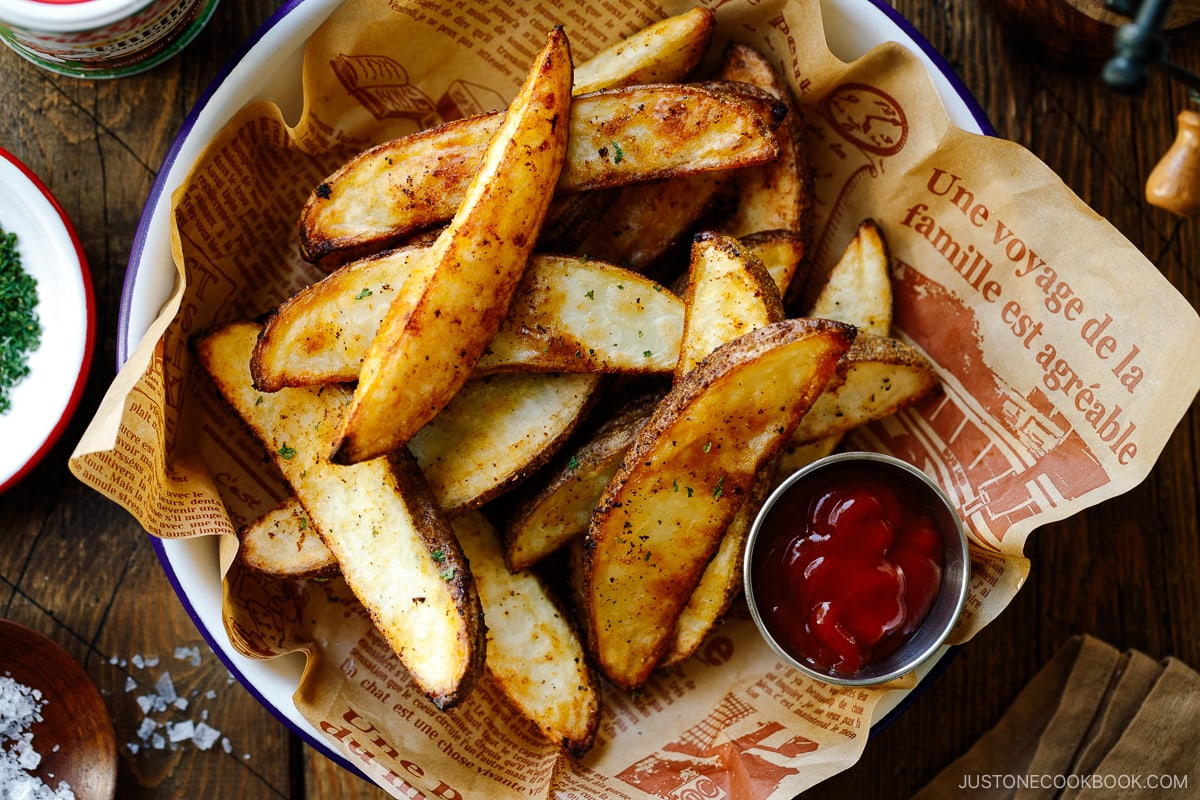
Serve the Hamburger Steak with Crispy Baked Potato Wedges, steamed broccoli, and sauteed carrots. If you want to make it into a Japanese-style meal, serve this dish with steamed rice and Miso Soup. You will have a fancy and extra special dinner that doesn’t cost a bomb. This is exactly the kind of recipe that calls for a bottle of red wine and a reason to celebrate.
Other Japanese Hamburger Recipes You’ll Enjoy
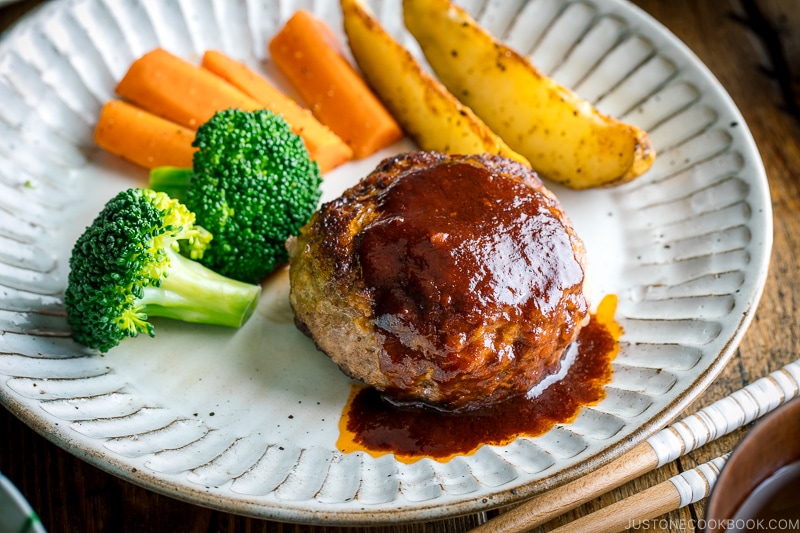
Wish to learn more about Japanese cooking? Sign up for our free newsletter to receive cooking tips & recipe updates! And stay in touch with me on Facebook, Pinterest, YouTube, and Instagram.
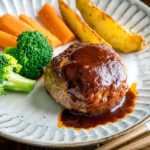
Japanese Hamburger Steak (Hambagu)
Video
Ingredients
For the Hambagu Patties
- ½ onion (5 oz, 142 g)
- 1 Tbsp neutral oil
- ¾ lb ground beef and pork combination (2 to 1 (8 oz/4 oz) or 3 to 1 (9 oz/3 oz) is a good beef-to-pork ratio)
- ½ tsp Diamond Crystal kosher salt
- freshly ground black pepper
- ½ tsp nutmeg
- ⅓ cup panko (Japanese breadcrumbs)
- 2 Tbsp milk
- 1 large egg (50 g each w/o shell)
For Cooking the Hambagu
- 1 Tbsp neutral oil
- 3 Tbsp red wine (for steaming; I use this mini wine; or substitute beef or chicken stock)
For the Sauce
- 1 Tbsp unsalted butter
- 3 Tbsp ketchup (to taste)
- 3 Tbsp tonkatsu sauce (or make Homemade Tonkatsu Sauce)
- 3 Tbsp red wine (I use this mini wine; or substitute beef or chicken stock)
- 3 Tbsp water
Instructions
Before You Start…
- Please note that this recipe requires 30 minutes of inactive resting time (patties in the refrigerator) in addition to the total active cooking time.
- Gather all the ingredients. If doubling the recipe, please cook one batch at a time in the pan.
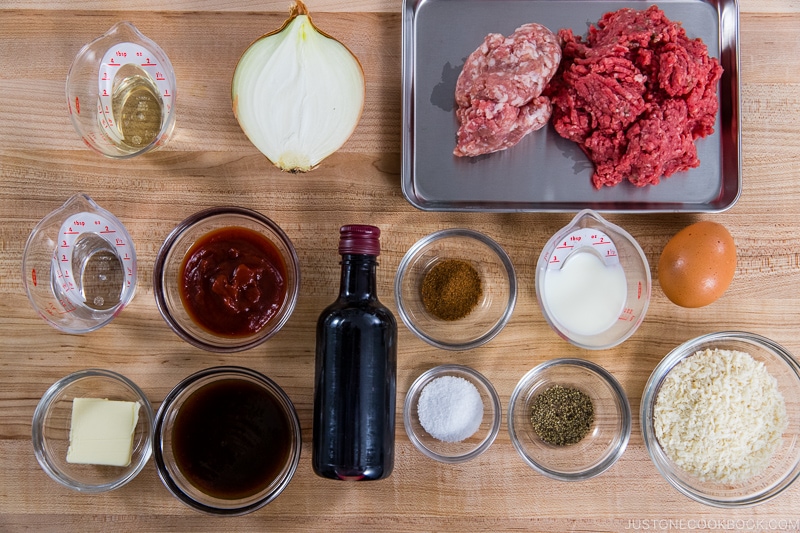
To Make the Hambagu Patties
- Mince ½ onion finely (we call this cutting technique mijingiri in Japanese). Lay the cut onion flat side down on the cutting board. With the knife tip pointing toward the root end, make ⅛-inch vertical slices to within ½ inch of the root end. With the knife edge toward the root end, make ⅛-inch horizontal slices, again keeping the root intact.
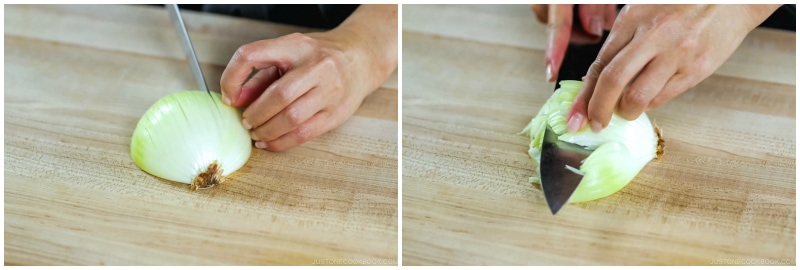
- Finally, make perpendicular cuts down through the vertical slices you made. If you need to chop the onions finer, run your knife through them using a rocking motion. Hold down the tip of the knife; otherwise, the onions will go flying around the room.
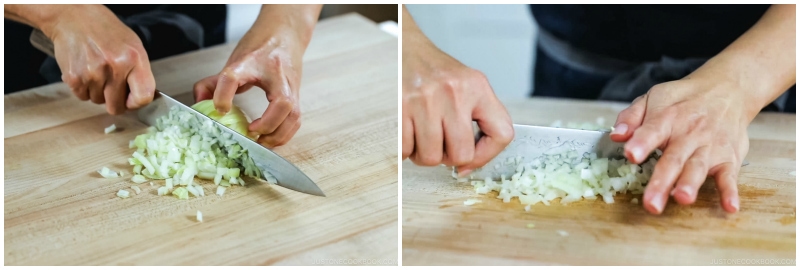
- Heat a large pan over medium heat. When the pan is hot, add 1 Tbsp neutral oil. Then, add the onions.
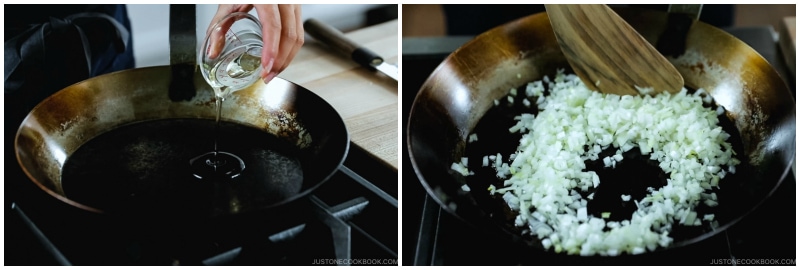
- Sauté the onions until tender and almost translucent. Transfer to a large bowl and let it cool.
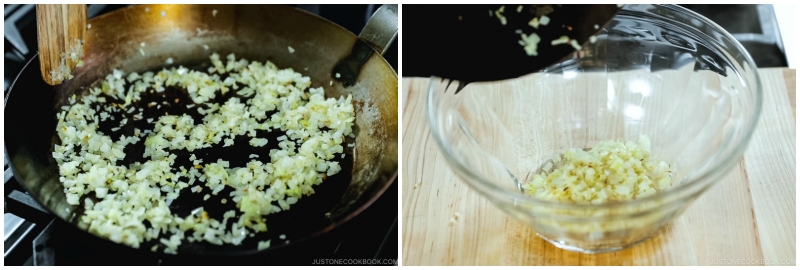
- Once the onions are cool, add ¾ lb ground beef and pork combination to the bowl. Add ½ tsp Diamond Crystal kosher salt, freshly ground black pepper as you like, and ½ tsp nutmeg. Tip: You can make hambagu with 100% beef, but it will not be as juicy and tender as combining the two meats.

- Add the ⅓ cup panko (Japanese breadcrumbs), 2 Tbsp milk, and 1 large egg (50 g each w/o shell).
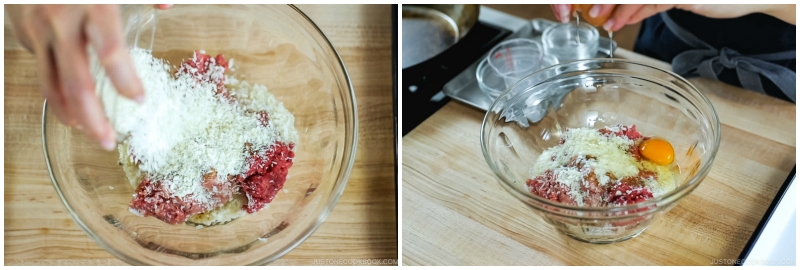
- Start mixing it all together with a silicone spatula or spoon.
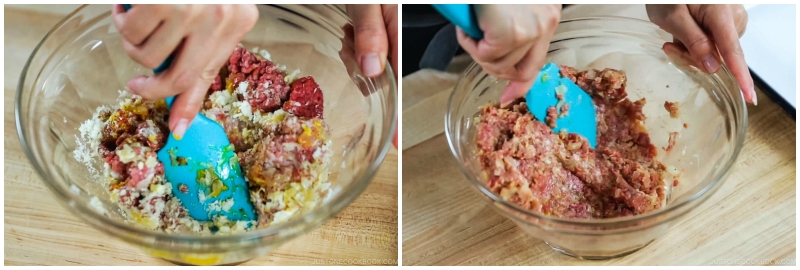
- Then, switch to mixing by hand and knead the mixture until it‘s sticky and pale.

- Divide the mixture into 4 portions (4 oz, 113 g each) or 6 smaller portions. Scoop out one portion.
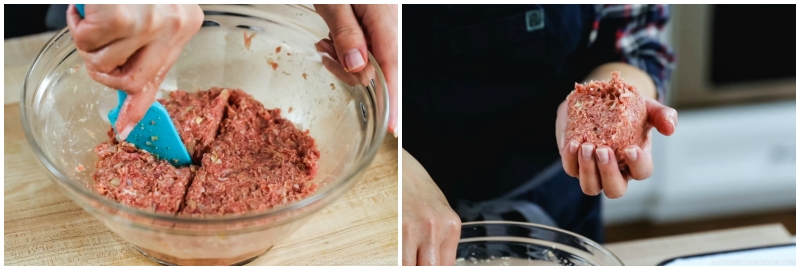
- Toss it from one hand to the other repeatedly about five times in order to release any air inside the mixture (see the video link above). Tip: Without releasing the air inside, the hamburger steaks will likely crack while cooking.

- Make an oval-shaped patty and place on a tray or plate. Repeat with the remaining portions. Cover the patties with plastic wrap and keep them in the refrigerator for at least 30 minutes before cooking so that the meat combines well and the fat solidifies.
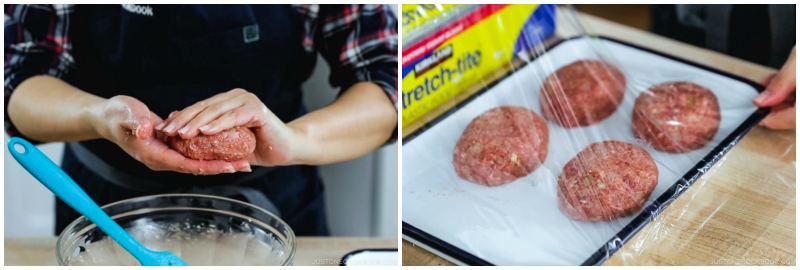
To Cook the Hambagu
- Heat a large pan over medium heat. (Cook one batch at a time if you‘re doubling the recipe.) When the pan is hot, add 1 Tbsp neutral oil. Place the patties gently into the pan. Indent the center of each patty with two fingers because the centers will rise with the heat.
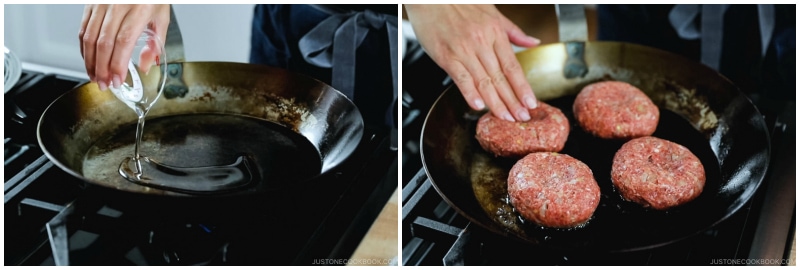
- Cook the patties until browned on the bottom side, about 3 minutes. Then, carefully flip and cook for another 3 minutes until browned.
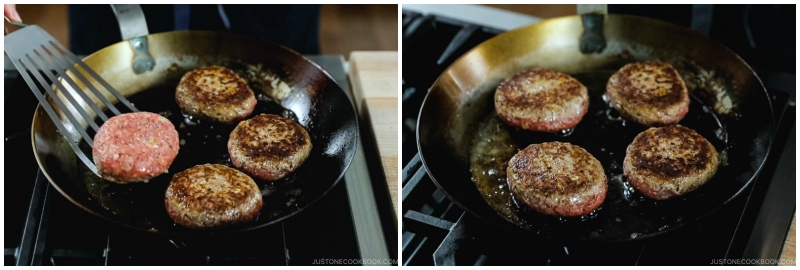
- Add 3 Tbsp red wine and reduce the heat to low. Cover the pan with a lid and cook for 5–7 minutes to thoroughly cook the inside of the patties (adjust the cooking time depending on the thickness of the patties).
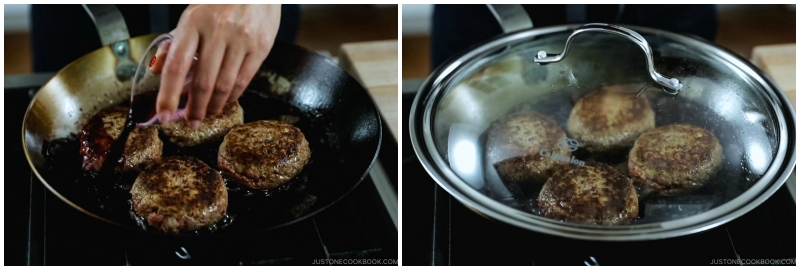
- Uncover and check that it‘s fully cooked by inserting a skewer; if clear juice comes out, it‘s done. Increase the heat to medium to let the alcohol finish evaporating. When it’s almost finished, transfer the hamburger steaks to individual plates. Do not wash the pan as you will make the sauce next using the pan juices.
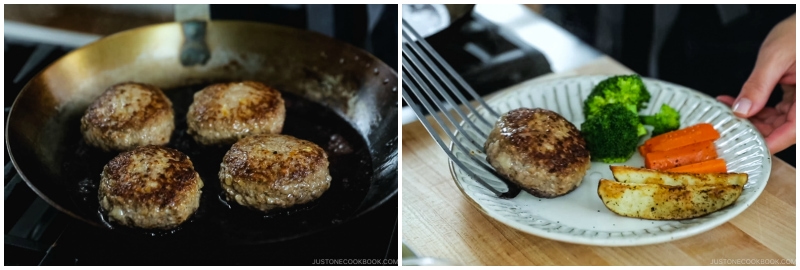
To Make the Red Wine Reduction Sauce
- To the same frying pan, add the ingredients for the sauce (for one batch): 1 Tbsp unsalted butter, 3 Tbsp ketchup, and 3 Tbsp tonkatsu sauce. Tip: Since some ketchup is sweeter than others, adjust the amount to taste. For the tonkatsu sauce, you can substitute Worcestershire sauce and sugar in a pinch.
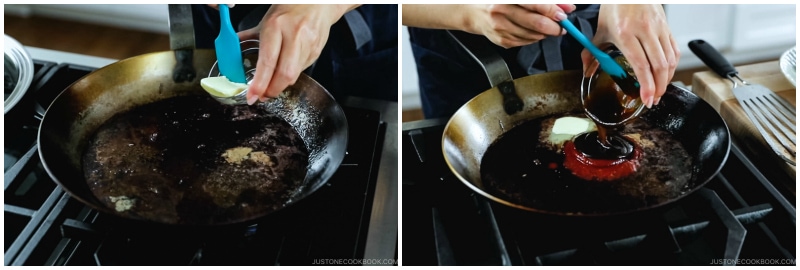
- Add 3 Tbsp red wine and 3 Tbsp water to the pan.
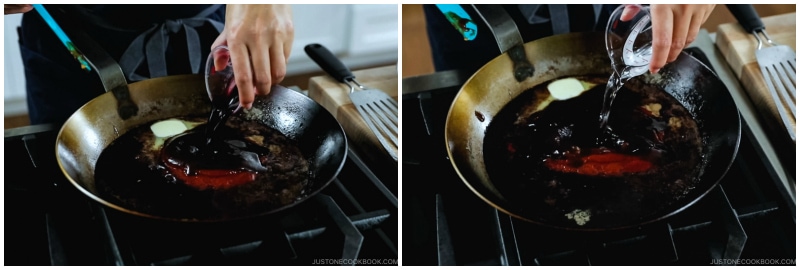
- Mix well together and bring the sauce to a simmer over medium heat; let the alcohol evaporate.
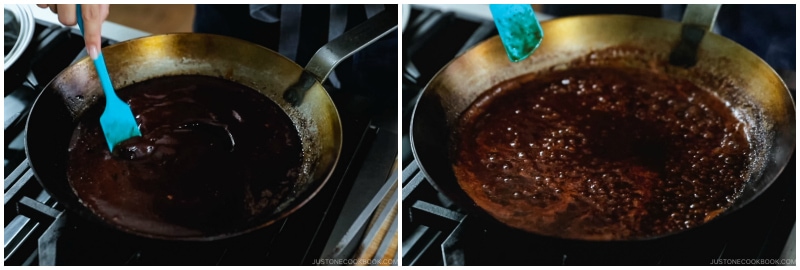
- When the sauce thickens (and you can draw a line on the bottom of the frying pan with a spatula), remove from the heat. Drizzle some sauce over the hamburger steaks.

To Serve
- Pour the remaining sauce into a small bowl or jar and bring it to the table for serving. We typically serve Steamed Rice, Homemade Miso Soup, Crispy Baked Potato Wedges, sauteed carrots, and steamed broccoli or a salad with this meal. Hambagu also goes well with Japanese Potato Salad and Corn Potage (Japanese Corn Soup).
To Store
- Transfer the leftover hamburger steaks to an airtight container and let them cool completely. You can store them in the refrigerator for up to 3 days and the freezer for up to a month.
Nutrition
Editor’s Note: The post was originally published on December 17, 2012. The content has been updated in August 2017. The post has been updated with a new video and images in June 2020.
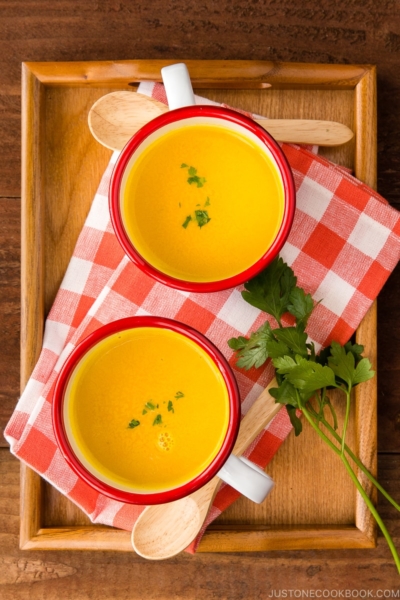

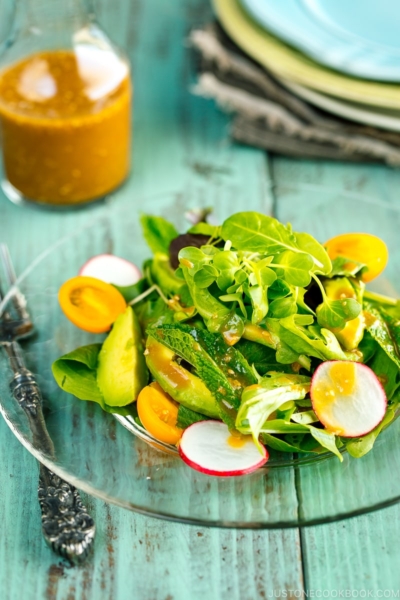

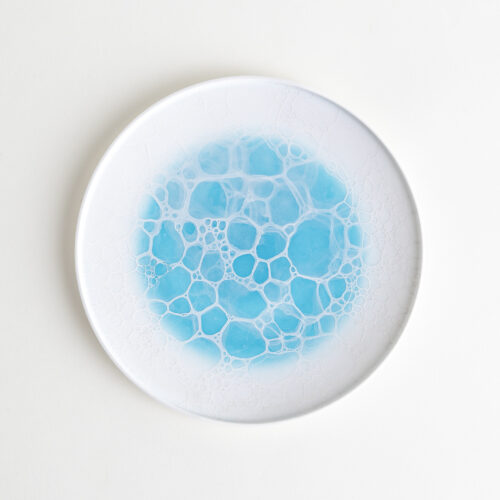
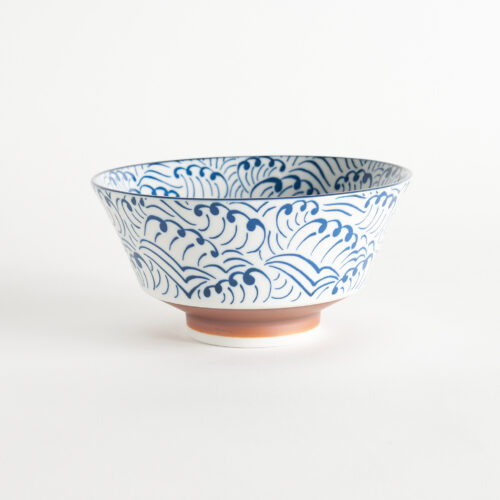
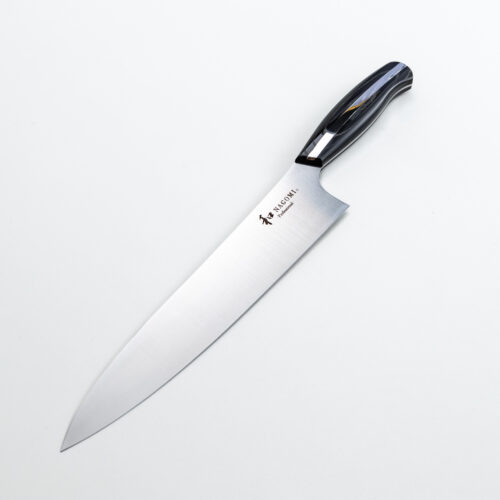
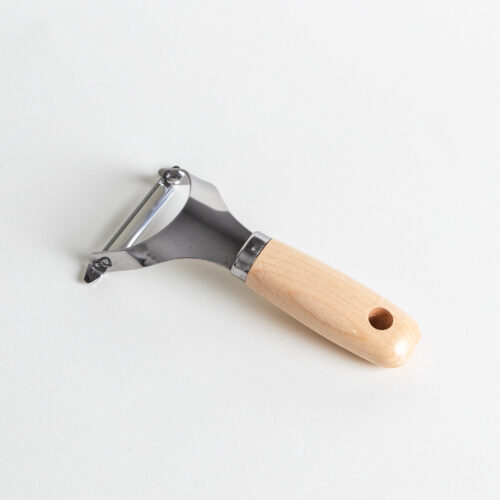

http://www.zeit.de/zeit-magazin/essen-trinken/2017-07/japanische-kueche-foodblog-just-one-cookbook-sonntagsessen
Well done and well deserved- congrats 🙂
Thank you so much, Susanne! xoxo
I finally got around to trying these and they were absolutely lovely and surprisingly easy. What would normally be done with leftover hambagu?
Thank you again for all the wonderful recipes! I absolutely adore Japanese food and this website really helps me to experience so much of what Japanese cuisine has to offer 🙂
Hi Emy! Thank you for trying this recipe! So glad you enjoyed it. I usually freeze the leftover in an airtight glass container for individual use (put 4 in each), so I can microwave directly. I use them for kids’ lunch box.
I’m happy to hear you have been cooking Japanese food at home! Thank you very much for following! xo
Hi Nami,
True, they really don’t need much, I just heated the leftovers and added a fried egg and it was delicious still the next day.
Been wanting to try this since I saw it on Netflix’s “Samurai Gourmet”. Will do it tonight…Thanks Nami
Hi Norman! I hope you enjoy(ed) this recipe! I like Samurai Gourmet too! Hope I can feature the recipes after my Midnight Diner series while we wait for Season 2. 🙂
My Osakan friend made me these when I visited her. I loved them, so good! I just made these steaks myself with this recipe and it turned out exactly like my friend ones <3 I'm happy! This website is such a treasure to me.
Hi Maarit! Aww thank you for your kind words. I’m so happy to hear you enjoyed this recipe! Thank you for your kind words!
Can we use ground turkey instead?
Hi ケイシ, The ground turkey should work, but the texture will be different and not as juicy and tender as combined meat.
You may adjust the recipe to add more moisture to the meatball.
We hope this helps!
Hi Nami, will the hambagu still taste good a day or two after cooking it? I was hoping to include this in my meal prep for next week. Thanks!
Hi Kim! I think if you refrigerate well, I think a day or two is good. To keep the flavor, it’s always best to freeze it though. I always freeze it if I don’t eat it next day. Hope you enjoy this recipe! 🙂
What if I don’t have red wine? Can I use rice wine or sake instead? Thank you ????
Hi Leony! To get savory deep sauce, red wine reduction tastes better and appropriate for this recipe. 🙂
I made this for the first time the other night. It was absolutely delicious. I made it with 60/40% hamburger/ground pork. My family completely loved it. Mahalo for another great recipe!
Hi Debbie! Yay!!! Super happy to hear that. Thanks so much for trying this recipe (and all other recipes). I love hearing from you. 🙂
Great post. I tried your recipe. It was delicious. All your tips were very helpful.
Thank you so much for trying this recipe, Fallon! I’m happy to hear you enjoyed it and thought the instructions were helpful. 🙂
I have made other hambagu recipes, but this was tops! I wouldn’t change a thing. The hamburgers were meltingly tender, and the sauce was delicious. I served it with rice and steamed leeks with sesame and sesame/miso sauce, with a little salad on the side. My Japanese homestay student, Shiju, loved it!
Hi Catherine! Wow thank you so much for your kind feedback! I’m so happy to hear you liked this recipe! I make this particular hambagu for years (wait, over a decade!). I’m glad your homestay student enjoyed it too! Your side dish sounds delicious! Thank you again!
Hi Nami this hamburger looks delish and easy to make btw may I use any kind of red wine ty
Hi Tina! Since you only need a small portion, I’d buy one that you would like to enjoy drinking as well. 🙂 Hope you enjoy this dish!
Thank you for sharing this wonderful recipe! The hambagu turned out so moist and it tastes so good and true to the Japanese flavor. My family loves it and I will definitely make it again and again =).
Hi iLaishan! Thank you so much for your kind feedback. I’m so glad your family enjoyed this recipe. It’s one of our family’s favorites too! 🙂
My son watched “Itadakimasu! Diing with the Chef” on NHK world and nagged me to get the recipe.
Simple to make and delicious! We are going to try other Japanese recipes from your site!
Many thanks and kind regards.
Hi Eugene! Thank you for trying this recipe! It “looks” complicated but it’s very simple when you start making it. I hope you enjoy other recipes from my site. Thank you for your kind feedback! 🙂
I made this tonight, and it turned out FANTASTIC! I invited my mother over to try them, and she loved them too. I even have one left for my bento lunch tomorrow, which is perfect! I served them with steamed long green beans and Japanese rice. Yum! Thank you for sharing all this delicious food with us.
PS- I was wondering if you have a favorite recipe for Okayu (お粥) that you would be willing to share? Since it is “cold and flu season,” I would like to try making that next time I’m not feeling too well. Also, if it is possible to make it in a rice cooker that does NOT have a separate porridge setting, I would love to know how to do it that way. If that’s not possible, then a stove-top method would be fine too.
Yay! Thank you so much for your feedback! I’m happy to hear you and your mom enjoyed this dish. 🙂 It’s a perfect bento dish too (meaning we can still enjoy at room temperature).
Since my daughter is currently sick with flu, I thought about making okayu too… if I can squeeze in photo shooting I may consider sharing it. We don’t normally eat okayu regularly (like Chinese enjoy for breakfast), I rarely make it unless someone is sick. 🙂 I never used rice cooker to make okayu (but I am sure mine has the setting). I always think it tastes better cooking in donabe (ceramic pot). If I cannot photo shoot this time, I keep okayu in my requested recipe list. Thanks!
I remember eating Japanese hamburgers in Japan when we were young. They were so delicious and asked our aunt for the recipe. I lost it many years later. I am happy to see it on your site. Delicious!!
Hi Nancy! I hope my recipe is as good as your aunt’s. Every family has their own way to make it, but basic ingredients etc are pretty much same. Hope you can adjust it to your liking! 🙂 Thank you so much for your feedback!
I always saw this on japanese shows I watch and always wondered how the sauce tastes. The patty is pretty similar how our family does burgers. We don’t have red wine here but is it ok to use other alcoholic drinks? Like vermouth?
Hi Mariah, We have never used vermouth for this recipe before and unsure how the outcome will be… Let us know how it goes!
Thank you for trying this recipe.🙂
This dish looks absolutely delicious! Thanks for sharing the tips about the process of forming the patties; that kind of knowledge must only come from experience and cooking with others in the kitchen. =)
Thank you Kimmi! 🙂
This is one of my favorite recipes. Is it possible to make the patties and freeze them raw to cook at a later date?
Hi Holly, We are glad to hear this is your favorite recipe! To store this type of patties, it’s better to cook first and freeze it. The defrosting process of uncooked patties will change these patties’ quality, and they will get soggy, and flavor and texture will change.
Tastes are much better if you cooked them first. We hope this helps!
Nami-san, we don’t drink in the house so we have no wine. Only cooking sake. Would it be possible to use chicken/beef broth + sake? Or broth + grape juice + sake? Or just broth + grape juice? ╮(. ❛ ᴗ ❛.)╭
Hi Fran! My suggestion in the recipe is to substitute with beef/chicken stock but your option is okay too! Probably subtle difference. 🙂
Thanks! Will try it later this week! These are very much like meatballs, aren’t they? (~ ̄³ ̄)~